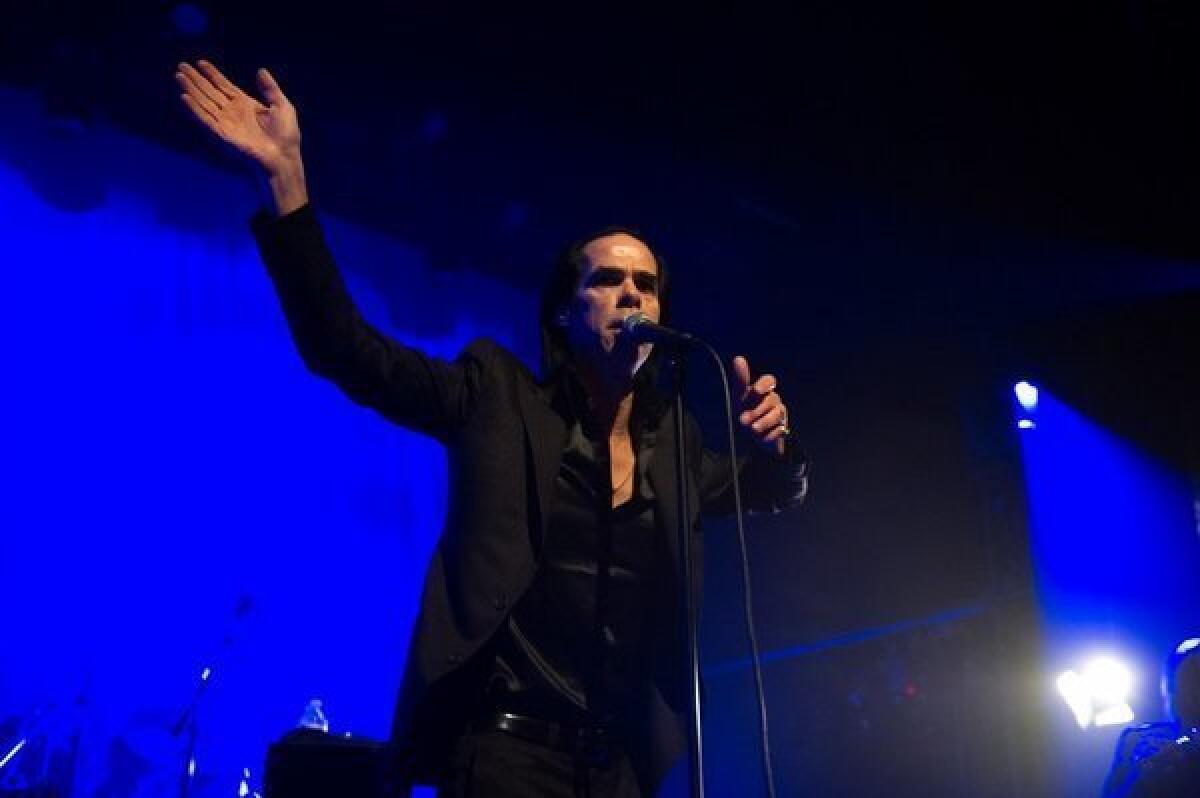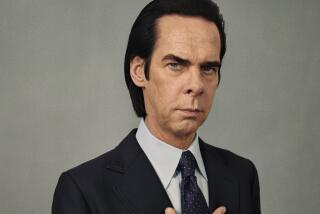SXSW 2013: Nick Cave on life spent in an ‘imaginative world’

AUSTIN, Texas -- Outspoken rock ‘n’ roll balladeer Nick Cave traced his beginnings from “rural Australia” to the more comforting confines of his own imagination in a sprawling, hour-long chat at the South by Southwest music conference here. The standing-room-only Tuesday conversation focused largely on Cave’s biographical history.
The facts of the real world, however, weren’t of as much interest to Cave as the more abstract matters of art.
Speaking of his relationship with spouse Susie Bick, Cave said, “I feel that I know her better in the songs that I write about her than I do in real life.” Speaking of wanting to leave rural Australia for Melbourne, and then later Melbourne for London and then London for New York, Cave said, “Culturally, life has been a series of disappointments.
PHOTOS: The scene at SXSW 2013
“It’s not,” he stressed, “that I can’t deal with the real world. The imaginative world to me is more reliable. I have more control over it. And in some ways, it’s more interesting.”
His early escape, as he told moderator/author Larry Sloman, was in discovering art books. “I read books about painters,” Cave said. “I knew something about art and was interested in art. I didn’t do sports, so it was very much assumed I was homosexual. Anyone who showed the vaguest artistic interest whatsoever was considered gay. That wasn’t so good. It toughed us up.”
Sloman asked Cave about stories that the young artist carried rocks in his handbag to throw at potential taunters, but Cave brushed it off to focus more on painting, how it led him to rock ‘n’ roll and how it changed his own images of self-worth. Struggling at a Melbourne art school, Cave began playing music with friends to get into gigs for free and to meet girls.
“It actually worked,” he said of meeting women. “It’s amazing it worked. In school, I was anti-magnet. They saw me coming, and they would just rush away. Things just immediately changed, in terms of my attractiveness. I was shocked by that.”
The conversation touched on Cave’s early bands the Boys Next Door and the Birthday Party, groups known for their violent, punk-inspired thrashing. The Birthday Party, said Sloman, was once billed as the “most violent band in the world.” Cave didn’t disagree, noting that weapons had to be confiscated before each gig. Eventually, Cave said he grew tired of the rowdy noise-rock and the fistfights.
“There was a lot of interplay between the audience and me that often got out of hand, I would say. Because of that, we attracted quite a reputation,” Cave said. “There were huge demands with us. We would play a concert and people would come and expect a certain kind of gig that was not so much about music but was about physical violence. We grew tired of that.”
STORY: 10 bands to watch at SXSW 2013
Sloman kept the conversation moving forward through Cave’s career, often reading back old quotes from earlier interviews. “Did I say that?” Cave asked. “Cool.” Cave hinted that the band had a rather contentious relationship with feminist groups in Australia, and he spoke of playing a gig at an unnamed college that devolved into a mess.
“We were often under attack from feminists,” Cave said. “Weirdly, that hasn’t changed. When I say under attack, I meant physically under attack. It’s changed now. The feminists in Australia…”
As Cave paused, Sloman asked the artist about the breakup of the Birthday Party. Cave ignored him and continued with his story.
“They actually gave us a list of songs that we could play,” Cave said. “We played a university -- the hub of free-thinking and all that stuff -- and someone had sat down and said, ‘These [songs] were acceptable and these ones weren’t.’ That was a recipe for a disaster.”
Instead of peppering Cave for more details, it was onto discussing the Bad Seeds. The last 20 minutes of conversation were a brisk rundown of albums, with a brief diversion into Cave’s thoughts on music critics. Sloman read Cave a line from a review of new album “Push the Sky Away,” from the New York Post: “If he’s rocking, it might be worth hearing. If he isn’t, it’s not.”
“That’s totally bummed me out,” Cave said.
Asked whether he still read reviews, Cave said, “Listen, I’ve spent my life butting my head against other people’s lack of imagination. To my undying shame, I do read reviews. I don’t read them all, but I like to get some kind of idea how things are going. I didn’t read that one, though.”
Cave appeared more interested in discussing the creative process than Sloman. When Sloman asked why there had once been a four-year gap between albums, Cave shrugged. “Maybe I was having a good time.”
The talk ended how it began, with Cave still speaking of his quest for an escape, either from rural Australia or the problems of daily life.
“It is very much an invented world that these songs operate in,” he said. “When the songs are looked at individually, they seem overwrought and hysterical and unreal. Within the context of the rest of the songs, there’s a world there they can live in.”
ALSO:
SXSW 2013: The music stories to watch
SXSW: 2013: Ten rising L.A. bands to look for in Austin
SXSW 2013: An hour in the life of a (very busy) festival
PHOTOS AND MORE
COACHELLA: Complete 2013 lineup
THE ENVELOPE: Awards Insider
PHOTOS: Grammy top winners
More to Read
The biggest entertainment stories
Get our big stories about Hollywood, film, television, music, arts, culture and more right in your inbox as soon as they publish.
You may occasionally receive promotional content from the Los Angeles Times.











